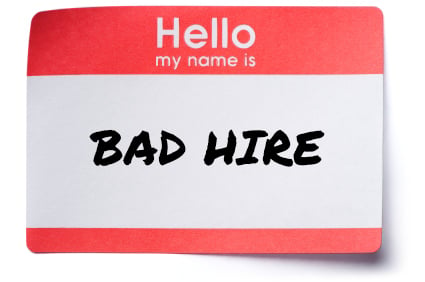If you’re a hiring manager at your organization, chances are you have had a couple of new hires that haven’t worked out the way you hoped, or as we call them - a mis-hire. The costs of a bad hire can be staggering when you really sit down and analyze them. In work done by Dr. Bradford Smart, author of Topgrading, the estimated cost of a bad hire ranges from 5 to 27 times the amount of the person’s actual salary. The good news is that there are ways to systematically reduce the chances of this happening on your next hire. According to Gallup mishires cost the US economy over 1 trillion dollars annually. How can you avoid this fixable problem? Read on.
When I first read that number, I thought it was a misprint; I mean, how can the costs be so high? 
Highlights of the types of costs involved in a bad hiring (or a good one):
Total Hiring Costs
- Cost of recruiting, the search, advertising, and referral fees associated with finding a candidate
- Outside testing, interviewing, record checking, and background check
- HR department time and administrative costs (for all candidates, not just the one that got hired)
- Time/expenses of non-HR people who take time out of their day to review resumes and conduct interviews with the candidate
- Time developing their job scorecard and posting their job description. Job Scorecard vs. Job Description: What's the Difference?
Compensation
- Salary and bonuses multiplied by the number of years employed (another great lesson is that if you do make a bad hire, the faster you correct it, the better off you will be!)
- Stock options, benefits, company car, and other direct business expenses
- Office “rental” for the hire
- Furniture, computer, equipment, travel for all years
- Training costs
Total Severance
- Severance fees (salary, benefits, use of office), lawyer fees
- Outplacement counseling fee
- Costs in lawsuits caused by the person (e.g., EEOC, harassment, EPA, OSHA, etc.)
- Administrative costs in separation, wasted time of people in separation
Opportunity Cost
- Loss of the new business, ideas and energy that a great employee would have brought to the organization
- Loss of production due to lower morale from other employees
- Value of a key customer who was lost or driven away
- Value of impaired customer loyalty
- Failed product launches that aren’t up to your organization’s high standards
- Lack of employee engagement caused by the bad hire.
Wasted Hours
- The number of additional hours you and others spent dealing with mis-hire’s weak points — patching things up with customers, re-doing and double checking work, etc.
- Bad hires are a waste of time and money and can have a negative effect on company culture.
- Wasted time from other team members that need to pick up the slack for the poor performers.
Once you do a similar exercise for your organization, you will quickly realize that you can’t afford not to make the investment in recruiting and retaining top-notch talent. That is where the Topgrading methodologies can help your organization overcome the challenges associated with hiring the right people to help your company prosper. Not all bad hiring decisions can be stopped, but using a proven methodology can help you mitigate the risk of talent acquisition.
Topgrading and Job Scorecards help navigate three of the biggest hiring challenges:
- Excessive exaggeration and dishonesty (if not outright lying) on resumes as the Topgrading process forces candidates to walk the employer through their past accomplishments
- Insufficient information regarding the candidate as most interviews focus solely on competency interviews
- Lack of verifiability as most reference checks are referred to Human Resources who provide yes/no answers with no comments on the quality of the work.
If you go through this exercise, chances are you will be surprised at just how much a new hire costs and how long it can take to recover from hiring the wrong person. While Topgrading can’t guarantee success with every new hire, following the methodology greatly increases your chances of hiring high-quality candidates. Even if following this process increases the amount of time dedicated to your interviewing process, it makes up for it in the long term as you avoid bad hires and retain top talent.
If you want to learn more about the Topgrading process, please read my colleague Alan Gehringer’s blog post from earlier this year and visit Topgrading.com. There is no question that implementing Topgrading methodologies in your organization requires investment in time and resources. Still, chances are you can’t afford not to do this as the cost of a bad hire far outweighs this investment in time.
Download
Job Scorecard
Template
How to Keep Your Top Talent: 12 Actionable Tips for Engaging Talent
Measurable Criteria for Employee Recognition: Samples, Ideas and KPIs for Rewards
Employee Engagement and Recognition: Fuel Employee Engagement with a Recognition Culture
Employee Engagement and Motivation: How to Motivate and Engage your Employees
Employee Engagement Ideas for Manufacturing Industry: 11 Actionable Tips from our Experts
How to Avoid the Staggering Cost of a Mishire: The Cost of a Bad Hire in 2022
Recruiting A Players: How to Find and Develop Topgrading "A Players"
Strengthsfinder for Teams: Engage Your Team By Focusing on Their StrengthsRhythm Systems
Photo Credit: iStock by Getty Images
Rhythm Systems Employee Engagement Resource Center



